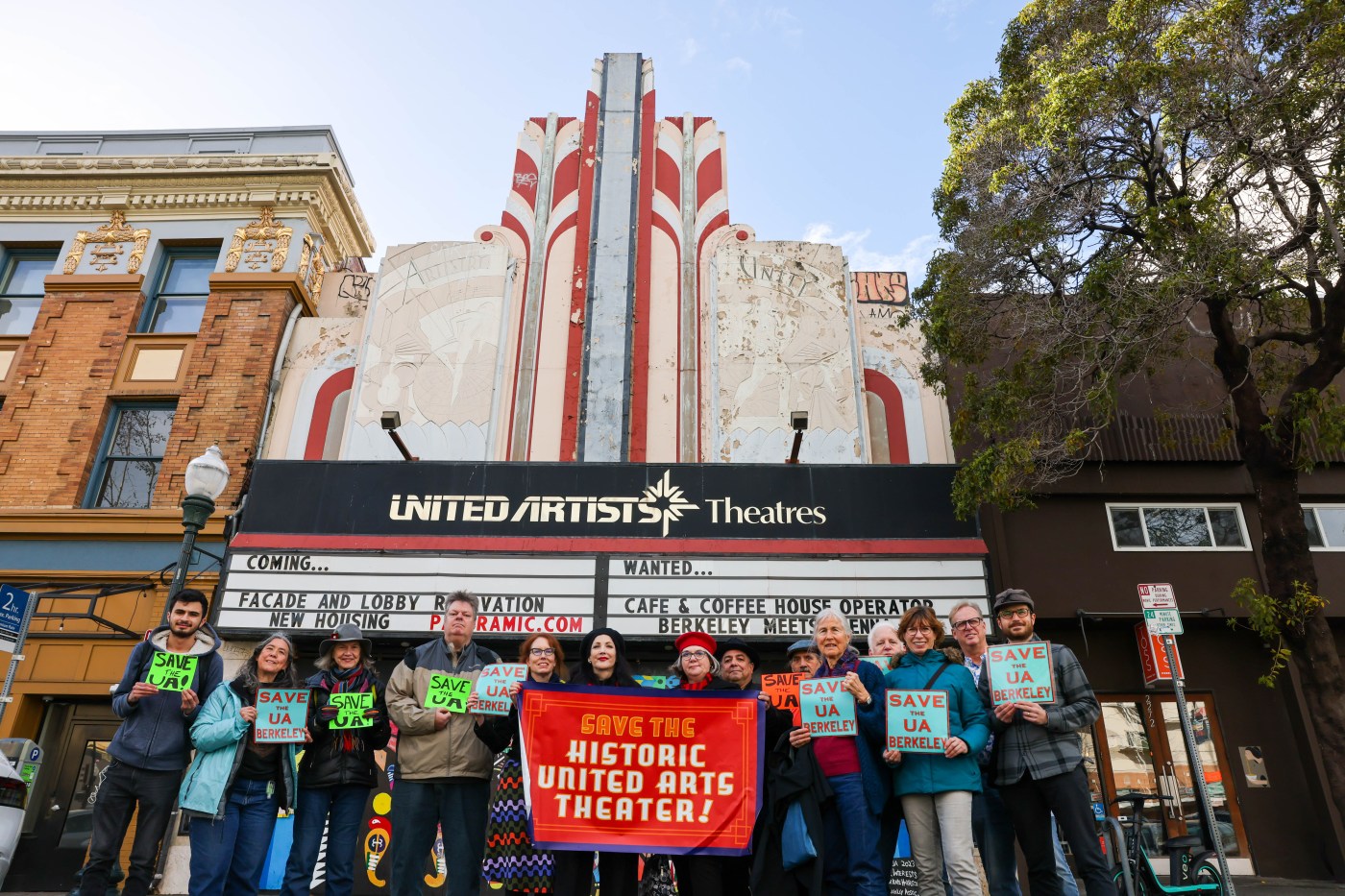BERKELEY — The fate of a historic Berkeley theater proposed for redevelopment into a downtown housing complex may soon be decided by the city council, which has been asked to save the 90-year-old art space by a group of concerned residents.
The United Artists Theater at 2274 Shattuck Ave. was once a grand 1,800-seat movie palace featuring a classic Art Deco design, large murals, intricate interior details, a 25-foot deep stage, electric concert organs and a glowing marquee.
Opened in 1932, the theater was part of a chain of film houses developed during the Great Depression by the United Artists Corporation, a production company founded by film legends like Charlie Chaplin who attended the grand opening of the Berkeley theater.
(photo courtesy of Save the UA Berkeley)Crowds flock to the Sept. 16, 1932, opening of downtown Berkeley’s United Artists Theater. The sellout crowd included Hollywood stars Mary Pickford and Bing Crosby, who signed autographs for the happy theater-goers.
The United Artists Theater, known locally as the UA Theater, underwent a variety of changes over the decades, including the replacement and eventual removal of its towering “United Artists” sign. Potentially the most notable renovation came in the 1970s when the auditorium was divided into seven separate screening rooms, an arrangement that would stick until Cineworld shut down the theater in 2023.
Instead of displaying the titles of debut films, the marque now advertises a new housing development that’s slated to take the theater’s space. Panoramic Interests, the developer behind the project, proposes building a 17-story, 227-unit apartment complex with a ground floor cafe.
Nearly all of the theater would be demolished to make way for the new high rise except for the existing facade, which the city’s Landmarks Preservation Commission deemed a historic resource in 2024.
Having undergone a series of reviews and awarded city approvals, all that’s standing in the project’s way now is a group of concerned residents dubbed Save the United Artists Theater Berkeley. What started out as a Facebook post by group founder Rose Ellis grew into an organized movement of people determined to see the theater preserved.
“A lot of people think it’s a creepy, ugly theater because they’ve never seen what’s behind the multiplex walls. There would be a lot of public passion and fight to save this building if they realized this was a Mona Lisa behind the tarp,” said Ellis, who said she knew the theater was magical even as a little girl.
Laura Linden, second from left, Rose Arpagian Ellis, fourth from left, along with supporters of Save United Artists Theater Berkeley, stand in front of the United Artists Theater in Berkeley, Calif., on Wednesday, Feb. 7, 2024. The group is trying to save the historic theater from demolition for a housing development. (Ray Chavez/Bay Area News Group)
The group is now appealing a decision by the city’s Zoning Adjustment Board to allow the theater to be demolished. A hearing on that appeal will be held during a special Berkeley City Council meeting Tuesday.
Related Articles
The CEQA graveyard: Projects delayed by California’s powerful environmental law
CEQA makes it ‘too damn hard’ to build. But do Democrats have the will to reform it?
Oakland apartment tower swiftly lands local buyer after foreclosure
Top bidder emerges for US Geological Survey campus in Menlo Park
First manufactured homes arrive at new Half Moon Bay farmworker housing project
Members of the UA Theater preservation campaign assert the city improperly allowed Panoramic Interests to forgo a full environmental review, which they say is required because the theater is listed on the California Register of Historical Resources.
A historic resources evaluation by Left Coast Architectural History, a firm contracted by Panoramic Interests, asserts the UA Theater has undergone substantial alterations that disqualify it from being a historic resource in need of preservation under current standards.
The Left Coast evaluation found that by preserving the facade, Panoramic Interests would be meeting necessary historic preservation guidelines.
Alternatively, two city-commissioned peer reviews of the Left Coast evaluation conducted by the Rincon Group dispute the report’s claims. Rincon’s report argues that what modifications have been made to the building have not substantially changed its historic merit and demolishing the building would have a significant impact on a historic site.
Despite Rincon’s findings, staff still recommended the Zoning Adjustment Board approve Panoramic’s request to demolish most of the structure without conducting a full California Environmental Quality Act review.
Of greater concern to Ellis and fellow Save the UA group member Laura Linden was that the Rincon findings were not presented to decision makers, a fact acknowledged by city staff in a report to the council. Their hope is that Rincon’s findings will compel the council to call for a proper environmental review.
“We know with all these laws we can’t stop this project and the council won’t or can’t vote down the project, but we think this is the right legal remedy,” Linden said about reversing the Zoning Adjustment Board’s decision.
When asked about the peer review, city staff highlighted a section of a report which noted all relevant materials were reviewed before a recommendation was made to decision making bodies. City spokesperson Seung Lee said the city had no further comment on the matter.
Representatives with Panoramic Interests did not respond to a request for comment but firm owner Patrick Kennedy has previously dismissed the campaign to this news organization as a misguided and uninformed, “thinly veiled NIMBY action.”
“Right now they’re trying to landmark a cheesy 1992 marquee with a dilapidated plaster front that completely hides the art deco bas relief plasters and is slowly falling apart,” Kennedy previously said.
Lobby of the United Artists theater at 2274 Shattuck Ave. in downtown Berkeley, showing ornamental plasterwork, French mirrors, custom chandeliers and original wood doors with etched glass panels. Supporters of the Art Deco theater say it is protected under state law and the city must not let a developer rush to destroy the bulk of it, as is currently proposed. The Berkeley City Council appeal hearing is scheduled for April 22, 6 p.m., at 1231 Addison St. and online. For more information, see the meeting agenda at https://berkeleyca.gov/your-government/city-council/city-council-agendas. (Courtesy of Save the UA Berkeley)
Proponents of Panoramic’s proposal have argued in public comments and letters to Berkeley officials that the project would bring much needed housing to the city.
Instead of preserving what some have argued is a “seismically unsound” building that “poses a health and safety risk to the public,” Berkeley would be better served by an estimated $7 million in development fees, $2 million annually in property taxes and hundreds of new homes, proponents said in letters to the city.
“There is a way to honor the history of the theater while also building badly-needed housing, and this proposal aims to do just that,” read multiple similarly drafted letters submitted to the Zoning Adjustment Board last December.
Downtown housing development has been largely stagnant due to unfavorable market conditions though, according to recent reporting cited by Linden and Ellis. What they described as a “gaping crater” now exists where the former Shattuck Cinemas once stood before being demolished to make way for new housing.
An 18-story apartment complex is also slated to replace the California Theatre on Kittredge Street, though developers behind that project plan to construct a 24,273-square-foot live performance space on the ground floor and retain the venue’s facade.
The question of what to do with the United Artists Theater is similarly not an either-or issue, Linden said. Housing could theoretically be built on top of the existing United Artists theater structure and its interior restored to its original form, revealing the original stage that possibly remains intact behind the multiplex walls, she argued.
That work would likely be costly, Linden acknowledged, but the group argues it’s legally required to preserve what the state has already deemed a historical site worth protecting. Breathing new life into the venue could also serve as a community benefit by providing a mid-sized theater space for community events and live performances, Linden said.
“The first thing is don’t destroy. All options are gone if it’s demolished and we’ll never bring back a theater like the UA once it’s gone,” Linden said. “Something like this is irreplaceable.”





